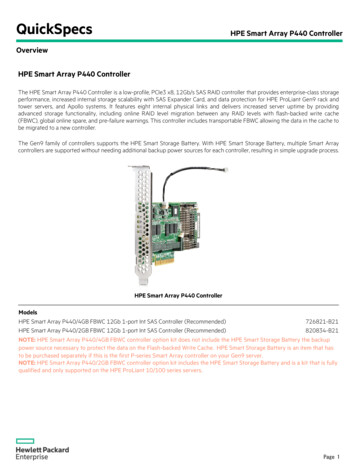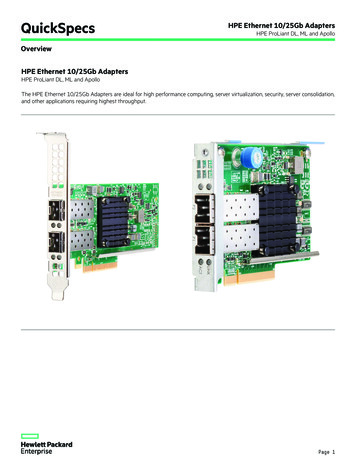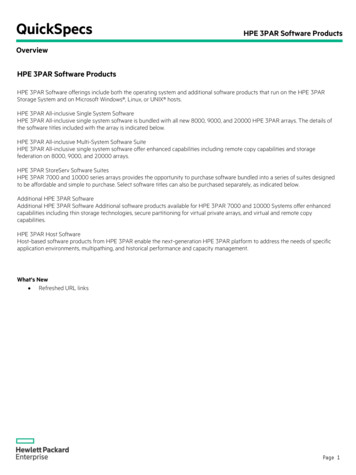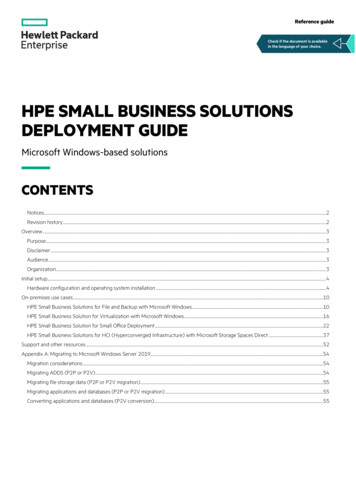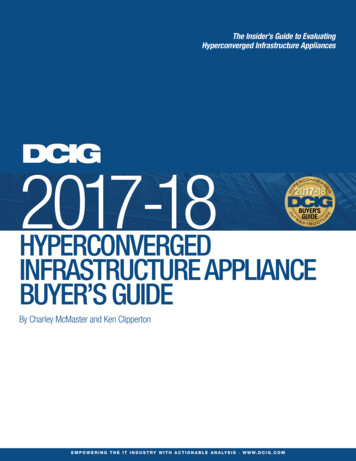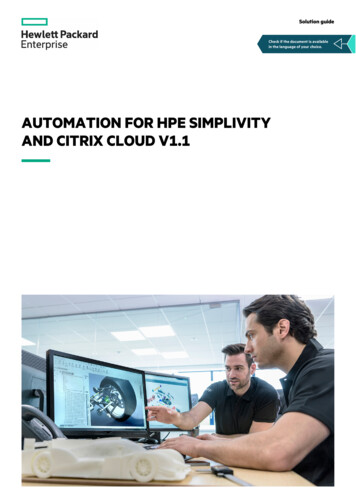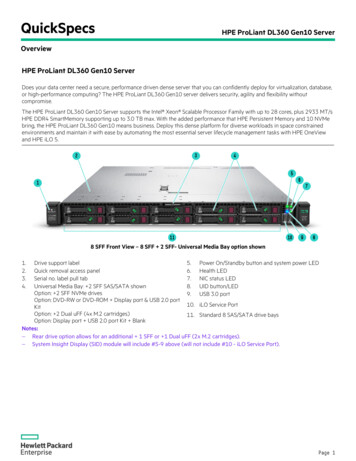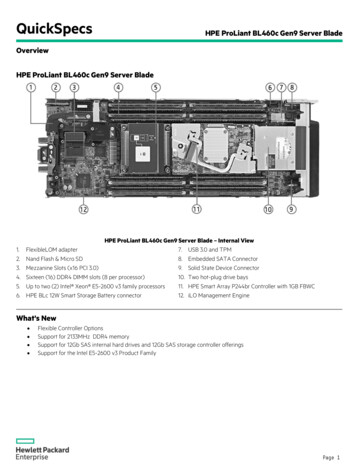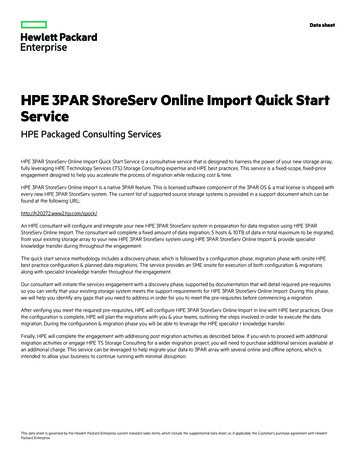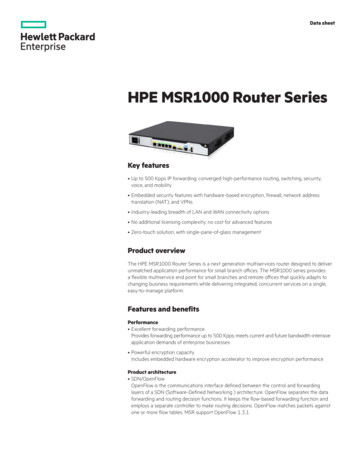
Transcription
Data sheetHPE MSR1000 Router SeriesKey features Up to 500 Kpps IP forwarding; converged high-performance routing, switching, security,voice, and mobility Embedded security features with hardware-based encryption, firewall, network addresstranslation (NAT), and VPNs Industry-leading breadth of LAN and WAN connectivity options No additional licensing complexity; no cost for advanced features Zero-touch solution, with single-pane-of-glass managementProduct overviewThe HPE MSR1000 Router Series is a next generation multiservices router designed to deliverunmatched application performance for small branch offices. The MSR1000 series providesa flexible multiservice end point for small branches and remote offices that quickly adapts tochanging business requirements while delivering integrated, concurrent services on a single,easy-to-manage platform.Features and benefitsPerformance Excellent forwarding performanceProvides forwarding performance up to 500 Kpps; meets current and future bandwidth-intensiveapplication demands of enterprise businesses Powerful encryption capacityIncludes embedded hardware encryption accelerator to improve encryption performanceProduct architecture SDN/OpenFlowOpenFlow is the communications interface defined between the control and forwardinglayers of a SDN (Software-Defined Networking ) architecture. OpenFlow separates the dataforwarding and routing decision functions. It keeps the flow-based forwarding function andemploys a separate controller to make routing decisions. OpenFlow matches packets againstone or more flow tables. MSR support OpenFlow 1.3.1
Data sheetPage 2 Ideal multiservice platformProvides WAN router, Ethernet switch, wireless LAN, 3G or 4G WAN, firewall, VPN, and SIPor voice gateway all in one box High-density voice interfacesProvide flexible analog voice interface options for easy integration within a wide rangeof deployments USB interfaceUses USB memory disk to download and upload configuration files; supports an externalUSB 3G modem for a 3G WAN uplink Advanced hardware architectureDelivers Gigabit Ethernet switching and a PCIe busConnectivity VXLAN (Virtual eXtensible LAN)VXLAN (Virtual eXtensible LAN, scalable virtual local area network) is an IP-based network,using the “MAC in UDP” package of Layer VPN technology. VXLAN can be based on an existingISP or enterprise IP networks for decentralized physical site provides Layer 2 communication,and can provide service isolation for different tenants Virtual Private LAN Service (VPLS)Virtual Private LAN Service (VPLS) delivers a point-to-multipoint L2VPN service overan MPLS or IP backbone. The backbone is transparent to the customer sites, which cancommunicate with each other as if they were on the same LAN. The following protocolssupport on MSRs, RFC4447, RFC4761 and RFC4762, BFD detection in VPLS, Supporthierarchical HOPE(H-VPLS), MAC address recovery in H-VPLS to speed up convergence NEMO (Network Mobility)Network mobility (NEMO) enables a node to retain the same IP address and maintainapplication connectivity when the node travels across networks. It allows location-independentrouting of IP datagrams on the Internet Packet storm protectionProtects against broadcast, multicast, or unicast storms with user-defined thresholds LoopbackSupports internal loopback testing for maintenance purposes and an increase in availability;loopback detection protects against incorrect cabling or network configurations and can beenabled on a per-port or per-VLAN basis for added flexibility 3G/4G access supportProvides 3G/4G LTE wireless access for primary or backup connectivity via a 3G/4G LTE SICmodules certified on various cellular networks; optional carrier 3G/4G USB modems available Flexible port selectionProvides a combination of fiber and copper interface modules, 100/1000BASE-X auto-speedselection, and 10/100/1000BASE-T auto-speed detection plus auto duplex and MDI/MDI-X Multiple WAN interfacesProvide a traditional link with E1, T1, ADSL, ADSL2, ADSL2 , G.SHDSL, Serial, and ISDNbackup; provide high-density Ethernet access with Fast Ethernet/Gigabit Ethernet, mobilityaccess with IEEE 802.11b/g/n Wi-Fi, and 3G/4G LTE options High-density port connectivityIntegrates four or eight Giga LAN switching ports (All switching ports can be configuredas routed ports.), two or three SIC slots, and up to 30 module options
Data sheetPage 3Layer 2 switching Spanning Tree Protocol (STP)Supports standard IEEE 802.1D STP, IEEE 802.1w Rapid Spanning Tree Protocol (RSTP)for faster convergence, and IEEE 802.1s Multiple Spanning Tree Protocol (MSTP) Internet Group Management Protocol (IGMP) and Multicast Listener Discovery (MLD)protocol snoopingControl and manage the flooding of multicast packets in a Layer 2 network Port mirroringDuplicates port traffic (ingress and egress) to a local or remote monitoring port VLANsSupport IEEE 802.1Q-based VLANs sFlowAllows traffic sampling Define port as switched or routedSupports command switch to easily change switched ports to routed (maximum eight GE ports)Layer 3 routing Static IPv4 routingProvides simple manually configured IPv4 routing Routing Information Protocol (RIP)Uses a distance vector algorithm with User Datagram Protocol (UDP) packets for routedetermination; supports RIPv1 and RIPv2 routing; includes loop protection Open Shortest Path First (OSPF)Delivers faster convergence; uses this link-state routing Interior Gateway Protocol (IGP), whichsupports ECMP, NSSA, and MD5 authentication for increased security and graceful restart forfaster failure recovery Border Gateway Protocol 4 (BGP-4)Delivers an implementation of the Exterior Gateway Protocol (EGP) utilizing path vectors; usesTCP for enhanced reliability for the route discovery process; reduces bandwidth consumptionby advertising only incremental updates; supports extensive policies for increased flexibility;scales to very large networks Intermediate system to intermediate system (IS-IS)Uses a path vector Interior Gateway Protocol (IGP), which is defined by the ISO organizationfor IS-IS routing and extended by IETF RFC 1195 to operate in both TCP/IP and the OSIreference model (Integrated IS-IS) Static IPv6 routingProvides simple manually configured IPv6 routing Dual IP stackMaintains separate stacks for IPv4 and IPv6 to ease the transition from an IPv4-only networkto an IPv6-only network design Routing Information Protocol next generation (RIPng)Extends RIPv2 to support IPv6 addressing OSPFv3Provides OSPF support for IPv6 BGP Extends BGP-4 to support Multiprotocol BGP (MP-BGP), including support for IPv6 addressing IS-IS for IPv6Extends IS-IS to support IPv6 addressing
Data sheetPage 4 IPv6 tunnelingAllows IPv6 packets to traverse IPv4-only networks by encapsulating the IPv6 packet intoa standard IPv4 packet; supports manually configured, 6 to 4, and Intra-Site AutomaticTunnel Addressing Protocol (ISATAP) tunnels; is an important element for the transitionfrom IPv4 to IPv6 Multiprotocol Label Switching (MPLS)Uses BGP to advertise routes across Label Switched Paths (LSPs), but uses simple labelsto forward packets from any Layer 2 or Layer 3 protocol, which reduces complexity andincreases performance; supports graceful restart for reduced failure impact; supports LSPtunneling and multilevel stacks Multiprotocol Label Switching (MPLS) Layer 3 VPNAllows Layer 3 VPNs across a provider network; uses Multiprotocol BGP (MP-BGP) to establishprivate routes for increased security; supports RFC 2547 multiple autonomous system VPNs foradded flexibility; supports IPv6 MPLS VPN Multiprotocol Label Switching (MPLS) Layer 2 VPNEstablishes simple Layer 2 point-to-point VPNs across a provider network using only MPLSLabel Distribution Protocol (LDP); requires no routing and therefore decreases complexity,increases performance, and allows VPNs of non-routable protocols; uses no routing informationfor increased security; supports Circuit Cross Connect (CCC), Static Virtual Circuits (SVCs),Martini draft, and Kompella draft technologies Policy routingAllows custom filters for increased performance and security; supports access control lists (ACLs),IP prefix, AS paths, community lists, and aggregate policiesLayer 3 services NAT-PTNetwork Address Translation – Protocol Translation (NAT-PT) enables communicationbetween IPv4 and IPv6 nodes by translating between IPv4 and IPv6 packets. It performsIP address translation, and according to different protocols, performs semantic translationfor packets. This technology is only suitable for communication between a pure IPv4 nodeand a pure IPv6 node WAN OptimizationMSR performs optimization using TFO and a combination of DRE, Lempel-Ziv (LZ)compression to provide the bandwidth optimization for file service and web applications.The policy engine module determines which traffic can be optimized and which optimizationaction should be taken. A pair of WAN optimization equipment can discover each otherautomatically and complete the negotiation to establish a TCP optimization session Address Resolution Protocol (ARP)Determines the MAC address of another IP host in the same subnet; supports static ARPs;gratuitous ARP allows detection of duplicate IP addresses; proxy ARP allows normal ARPoperation between subnets or when subnets are separated by a Layer 2 network User Datagram Protocol (UDP) helperRedirects UDP broadcasts to specific IP subnets to prevent server spoofing Dynamic Host Configuration Protocol (DHCP)Simplifies the management of large IP networks and supports client and server; DHCP Relayenables DHCP operation across subnetsQuality of service (QoS) Traffic policingSupports Committed Access Rate (CAR) and line rate Congestion managementSupports FIFO, PQ, CQ, WFQ, CBQ, and RTPQ
Data sheetPage 5 Weighted random early detection (WRED)/Random early detection (RED)Delivers congestion avoidance capabilities through the use of queue management algorithms Other QoS technologiesSupport traffic shaping, FR QoS, MPLS QoS, and MP QoS/LFISecurity IPSBuilt-in Intrusion Prevention System (IPS) detects and protects the branch office from securitythreats. Optional HPE integration filters for client-side, branch protection from exploits andvulnerabilities Zone based firewallZone-Based Policy Firewall changes the firewall configuration from the older interface-basedmodel to a more flexible, more easily understood zone-based model. Interfaces are assignedto zones, and inspection policy is applied to traffic moving between the zones. Inter-zonepolicies offer considerable flexibility and granularity, so different inspection policies can beapplied to multiple host groups connected to the same router interface Enhanced stateful firewallApplication layer protocol inspection, Transport layer protocol inspection, ICMP error messagecheck, and TCP SYN check. Support more L4 and L7 protocols like TCP, UDP, UDP-Lite,ICMPv4/ICMPv6, SCTP, DCCP, RAWIP, HTTP, FTP, SMTP, DNS, SIP, H.323, SCCP Auto Discover VPN (ADVPN)Collects, maintains, and distributes dynamic public addresses through the VPN AddressManagement (VAM) protocol, making VPN establishment available between enterprisebranches that use dynamic addresses to access the public network; compared to traditionalVPN technologies, ADVPN technology is more flexible and has richer features, such as NATtraversal of ADVPN packets, AAA identity authentication, IPSec protection of data packets,and multiple VPN domains Access control list (ACL)Supports powerful ACLs for both IPv4 and IPv6; ACLs are used for filtering traffic to preventunauthorized users from accessing the network, or for controlling network traffic to saveresources; rules can either deny or permit traffic to be forwarded; rules can be based ona Layer 2 header or a Layer 3 protocol header; rules can be set to operate on specific datesor times Terminal Access Controller Access-Control System (TACACS )Delivers an authentication tool using TCP with encryption of the full authentication request,providing additional security Network loginStandard IEEE 802.1x allows authentication of multiple users per port RADIUSEases security access administration by using a password authentication server Network address translation (NAT)Supports one-to-one NAT, many-to-many NAT, and NAT control, enabling NAT-PT tosupport multiple connections; supports blacklist in NAT/NAT-PT, and a limit on the numberof connections, session logs, and multi-instances Secure shell (SSHv2)Uses external servers to securely login to a remote device or securely login to MSR froma remote location; with authentication and encryption, it protects against IP spoofing andplain text password interception; increases the security of Secure File Transfer Protocol(SFTP) transfers
Data sheetPage 6 Unicast Reverse Path Forwarding (URPF)Allows normal packets to be forwarded correctly, but discards the attaching packet due to lackof reverse path route or incorrect inbound interface; prevents source spoofing and distributedattacks IPSec VPNSupports DES, Triple DES (3DES), and Advanced Encryption Standard (AES) 128/192/256encryption, and MD5 and SHA-1 authentication Attack detection and protectionResponding to network attacks and threats by MSR Comware, support max connectionlimitation, single-packet attacks protection, scanning attack protection, flood attack protection,TCP and ICMP Attack Protection and so onConvergence Internet Group Management Protocol (IGMP)Utilizes Any-Source Multicast (ASM) or Source-Specific Multicast (SSM) to manage IPv4multicast networks; supports IGMPv1, v2, and v3 Protocol Independent Multicast (PIM)Defines modes of Internet IPv4 and IPv6 multicasting to allow one-to-many and many-to-manytransmission of information; supports PIM Dense Mode (DM), Sparse Mode (SM), and Source-SpecificMulticast (SSM) Multicast Source Discovery Protocol (MSDP)Allows multiple PIM-SM domains to interoperate; is used for interdomain multicast applications Multicast Border Gateway Protocol (MBGP)Allows multicast traffic to be forwarded across BGP networks and kept separate from unicast trafficIntegration Embedded NetStreamImproves traffic distribution using powerful scheduling algorithms, including Layer 4 to 7 services;monitors the health status of servers and firewalls Embedded VPN and stateful firewallProvide enhanced stateful packet inspection and filtering; deliver advanced VPN services withTriple DES (3DES) and Advanced Encryption Standard (AES) encryption at high performanceand low latency, and application prioritization and enhancementResiliency and high availability Backup centerActs as a part of the management and backup function to provide backup for device interfaces;delivers reliability by switching traffic over to a backup interface when the primary one fails Virtual Router Redundancy Protocol (VRRP)Allows groups of two routers to dynamically back each other up to create highly availablerouted environments; supports VRRP load balancingManagement Ease of deploymentZero-touch deployment, supports TR-069, USB disk auto deployment and 3G SMS autodeployment Industry-standard CLI with a hierarchical structureReduces training time and expenses, and increases productivity in multivendor installations Management securityRestricts access to critical configuration commands; offers multiple privilege levels withpassword protection; ACLs provide Telnet and SNMP access; local and remote syslogcapabilities allow logging of all access
Data sheetPage 7 SNMPv1, v2, and v3Provide complete support of SNMP; provide full support of industry-standard ManagementInformation Base (MIB) plus private extensions; SNMPv3 supports increased security usingencryption Remote monitoring (RMON)Uses standard SNMP to monitor essential network functions; supports events, alarm, history,and statistics group plus a private alarm extension group FTP, TFTP, and SFTP supportOffers different mechanisms for configuration updates; FTP allows bidirectional transfers overa TCP/IP network; trivial FTP (TFTP) is a simpler method using User Datagram Protocol (UDP);Secure File Transfer Protocol (SFTP) runs over an SSH tunnel to provide additional security Debug and sampler utilitySupports ping and traceroute for both IPv4 and IPv6 Network Time Protocol (NTP)Synchronizes timekeeping among distributed time servers and clients; keeps timekeepingconsistent among all clock-dependent devices within the network so that the devices canprovide diverse applications based on the consistent time Information centerProvides a central repository for system and network information; aggregates all logs, traps,and debugging information generated by the system and maintains them in order of severity;outputs the network information to multiple channels based on user-defined rules Management interface controlProvides management access through modem port and terminal interface; provides accessthrough terminal interface, Telnet, or SSH Network Quality Analyzer (NQA)Analyzes network performance and service quality by sending test packets, and providesnetwork performance and service quality parameters such as jitter, TCP, or FTP connectiondelays; allows network manager to determine overall network performance and diagnose andlocate network congestion pointsAdditional information OPEX savingsSimplifies and streamlines deployment, management, and training through the use ofa common operating system, thereby cutting costs as well as reducing the risk of humanerrors associated with having to manage multiple operating systems across differentplatforms and network layers High reliabilityProvides a state-of-the-art unified code base Faster time to marketAllows new and custom features to be brought rapidly to market through engineeringefficiencies, delivering better initial and ongoing stability Green initiative supportProvides support for RoHS and WEEE regulationsWarranty and support 1-year WarrantySee hpe.com/networking/warrantysummary for warranty and support informationincluded with your product purchase. Software releasesTo find software for your product, refer to hpe.com/networking/support; for details on the softwarereleases available with your product purchase, refer to hpe.com/networking/warrantysummary
Data sheetPage 8HPE MSR1000 Router SeriesSpecificationsHPE MSR1002-4 AC Router(JG875A)HPE MSR1003-8 AC Router(JG732A) Comware V5 basedHPE MSR1003-8S AC Router (JH060A)Comware V7 basedI/O ports and slots2 SIC slots, or 1 DSIC slot1 RJ-45 autosensing 10/100/1000 WANport1 SFP fixed Gigabit Ethernet SFP port4 RJ-45 autosensing 10/100/1000 LANports1 Serial port3 SIC slots, or 1 DSIC slot, and 1 SIC slot2 RJ-45 autosensing 10/100/1000 WANports8 RJ-45 autosensing 10/100/1000 LANports3 SIC slots, or 1 DSIC slot, and 1 SIC slot2 RJ-45 autosensing 10/100/1000 WANports8 RJ-45 autosensing 10/100/1000 LANportsAdditional ports and slots1 USB 2.01 RJ-45 console port to access limitedCLI port1 USB 2.01 RJ-45 console port to access limitedCLI port1 USB 2.01 RJ-45 console port to access limitedCLI port3G, 4G LTE3G, 4G LTE3G, 4G LTE14.17(w) x 11.81(d) x 1.74(h) in(36 x 30 x 4.42 cm) (1U height)6.83 lb (3.10 kg)14.17(w) x 11.81(d) x 17.4(h)in(36 x 30 x 44.2 cm)6.94 lb (3.15 kg)14.17(w) x 11.81(d) x 17.4(h) in(36 x 30 x 44.2 cm)6.94 lb (3.15 kg)Memory and processorRISC @ 667 MHz, 1 GB DDR3 SDRAM,256 MB flashRISC @ 667 MHz, 512 MB DDR3 SDRAM,256 MB flashRISC @ 667 MHz, 1 GB DDR3 SDRAM,256 MB flashMounting and enclosureDesktop or can be mounted in a EIAstandard 19-inch telco rack when usedwith the rack-mount kit in the package.Desktop or can be mounted in a EIAstandard 19-inch telco rack when usedwith the rack-mount kit in the package.Desktop or can be mounted in a EIAstandard 19-inch telco rack when usedwith the rack-mount kit in the package.Up to 500 Kpps (64-byte packets)200000 entries (IPv4), 200000 entries(IPv6)200000 entries (IPv4), 200000 entries(IPv6)Up to 500 Kpps (64-byte packets)30000 entries (IPv4), 30000 entries(IPv6)30000 entries (IPv4), 30000 entries(IPv6)Up to 500 Kpps (64-byte packets)200000 entries (IPv4), 200000 entries(IPv6)200000 entries (IPv4), 200000 entries(IPv6)32 F to 113 F (0 C to 45 C)5% to 95%, noncondensing-40 F to 158 F (-40 C to 70 C)5% to 95%, noncondensingUp to 16,404 ft (5 km)32 F to 113 F (0 C to 45 C)5% to 95%, noncondensing-40 F to 158 F (-40 C to 70 C)5% to 95%, noncondensingUp to 16,404 ft (5 km)32 F to 113 F (0 C to 45 C)5% to 95%, noncondensing-40 F to 158 F (-40 C to 70 C)5% to 95%, noncondensingUp to 16,404 ft (5 km)50/60 Hz92 BTU/hr (97.06 kJ/hr)100—240 VAC, rated(depending on power supply chosen)30 W50/60 Hz65 BTU/hr (68.58 kJ/hr)100—240 VAC, rated(depending on power supply chosen)30 W50/60 Hz65 BTU/hr (68.58 kJ/hr)100—240 VAC, rated(depending on power supply chosen)30 WNotesMaximum power rating and maximum heatdissipation are the worst-case theoreticalmaximum numbers provided for planningthe infrastructure with fully loaded PoE(if equipped), 100% traffic, all ports pluggedin, and all modules populated.Maximum power rating and maximum heatdissipation are the worst-case theoreticalmaximum numbers provided for planningthe infrastructure with fully loaded PoE(if equipped), 100% traffic, all ports pluggedin, and all modules populated.Maximum power rating and maximum heatdissipation are the worst-case theoreticalmaximum numbers provided for planningthe infrastructure with fully loaded PoE(if equipped), 100% traffic, all ports pluggedin, and all modules populated.AP characteristicsRadios (via optional modules)Physical utRouting table sizeForwarding table sizeEnvironmentOperating temperatureOperating relative humidityNonoperating/Storage temperatureNonoperating/Storage relative humidityAltitudeElectrical characteristicsFrequencyMaximum heat dissipationAC voltageMaximum power rating
Data sheetSpecificationsPage 9HPE MSR1002-4 AC Router(JG875A)HPE MSR1003-8 AC Router(JG732A) Comware V5 basedHPE MSR1003-8S AC Router (JH060A)Comware V7 based137.5137.5137.5SafetyUL 60950-1; IEC 60950-1; EN 60950-1;CAN/CSA-C22.2 No. 60950-1;FDA 21 CFR Subchapter J; AS/NZS 60950-1; GB 4943.1UL 60950-1; IEC 60950-1; EN 60950-1;CAN/CSA-C22.2 No. 60950-1;FDA 21 CFR Subchapter J; AS/NZS 60950-1; GB 4943.1UL 60950-1; IEC 60950-1; EN 609501; CAN/CSA-C22.2 No. 60950-1;FDA 21 CFR Subchapter J; AS/NZS 60950-1; GB 4943.1EmissionsVCCI Class A; EN 55022 Class A;CISPR 22 Class A; EN 55024;ICES-003 Class A; EN 300 386;CISPR 24; AS/NZS CISPR 22 Class A;EN 61000-3-2; EN 61000-3-3;FCC (CFR 47, Part 15) Class AVCCI Class A; EN 55022 Class A;CISPR 22 Class A; EN 55024;ICES-003 Class A; EN 300 386;CISPR 24; AS/NZS CISPR 22 Class A;EN 61000-3-2; EN 61000-3-3;FCC (CFR 47, Part 15) Class AVCCI Class A; EN 55022 Class A;CISPR 22 Class A; EN 55024;ICES-003 Class A; EN 300 386;CISPR 24; AS/NZS CISPR 22 Class A;EN 61000-3-2; EN 61000-3-3;FCC (CFR 47, Part 15) Class ATelecomFCC part 68; CS-03FCC part 68; CS-03FCC part 68; CS-03ManagementIMC—Intelligent Management Center;command-line interface; Web browser;out-of-band management (serial RS-232C);out-of-band management (DB-9 serialport console); SNMP Manager; Telnet;RMON1; FTP; IEEE 802.3 Ethernet MIBIMC—Intelligent Management Center;command-line interface; Web browser;out-of-band management (serial RS-232C);out-of-band management (DB-9 serialport console); SNMP Manager; Telnet;RMON1; FTP; IEEE 802.3 Ethernet MIBIMC—Intelligent Management Center;command-line interface; Web browser;out-of-band management (serial RS-232C);out-of-band management (DB-9 serial portconsole); SNMP Manager; Telnet; RMON1;FTP; IEEE 802.3 Ethernet MIBServicesRefer to the Hewlett Packard Enterprisewebsite at hpe.com/networking/servicesfor details on the service-level descriptionsand product numbers. For details aboutservices, and response times in your area,please contact your local Hewlett PackardEnterprise sales office.Refer to the Hewlett Packard Enterprisewebsite at hpe.com/networking/servicesfor details on the service-level descriptionsand product numbers. For details aboutservices, and response times in your area,please contact your local Hewlett PackardEnterprise sales office.Refer to the Hewlett Packard Enterprisewebsite at hpe.com/networking/servicesfor details on the service-level descriptionsand product numbers. For details aboutservices, and response times in your area,please contact your local Hewlett PackardEnterprise sales office.BGPRFC 1163 Border Gateway Protocol (BGP)RFC 1267 Border Gateway Protocol 3(BGP-3)RFC 1657 Definitions of Managed Objectsfor BGPv4RFC 1771 BGPv4RFC 1772 Application of the BGPRFC 1773 Experience with the BGP-4ProtocolRFC 1774 BGP-4 Protocol AnalysisRFC 1965 BGP-4 confederationsRFC 1997 BGP Communities AttributeRFC 2439 BGP Route Flap DampingRFC 2547 BGP/MPLS VPNsRFC 2796 BGP Route ReflectionRFC 2842 Capability Advertisement withBGP-4RFC 2858 BGP-4 Multi-ProtocolExtensionsRFC 2918 Route Refresh CapabilityRFC 3065 Autonomous SystemConfederations for BGPRFC 3107 Support BGP carry Label forMPLSRFC 3392 Capabilities Advertisementwith BGP-4RFC 4271 A Border Gateway Protocol 4(BGP-4)RFC 4273 Definitions of Managed Objectsfor BGP-4RFC 4274 BGP-4 Protocol AnalysisRFC 4275 BGP-4 MIB ImplementationSurveyRFC 4276 BGP-4 Implementation ReportRFC 4277 Experience with the BGP-4ProtocolRFC 4360 BGP Extended CommunitiesAttributeRFC 4456 BGP Route Reflection: AnAlternative to Full Mesh Internal BGP (IBGP)RFC 4724 Graceful Restart Mechanismfor BGPRFC 4760 Multiprotocol Extensions forBGP-4RFC1998 An Application of the BGPCommunity Attribute in Multi-home RoutingDenial of service protectionCPU DoS ProtectionRate Limiting by ACLsReliabilityAvailabilityStandards and Protocols(applies to JG875A and JH060A models)
Data sheetPage 10Standards and Protocols(applies to JG875A and JH060A models)Device managementRFC 1155 Structure and Mgmt Information(SMIv1)RFC 1157 SNMPv1/v2cRFC 1305 NTPv3RFC 1591 DNS (client)RFC 1902 (SNMPv2)RFC 1908 (SNMP v1/2 Coexistence)RFC 1945 Hypertext Transfer Protocol—HTTP/1.0RFC 2271 FrameworkRFC 2573 (SNMPv3 Applications)RFC 2576 (Coexistence between SNMPV1, V2, V3)RFC 2578-2580 SMIv2RFC 2579 (SMIv2 Text Conventions)RFC 2580 (SMIv2 Conformance)RFC 3416 (SNMP Protocol Operations v2)RFC 3417 (SNMP Transport Mappings)General protocolsRFC 768 UDPRFC 760 DoD standard Internet ProtocolRFC 764 Telnet Protocol specificationRFC 777 Internet Control MessageProtocolRFC 783 TFTP Protocol (revision 2)RFC 791 IPRFC 792 ICMPRFC 793 TCPRFC 813 Window and AcknowledgementStrategy in TCPRFC 815 IP datagram reassemblyalgorithmsRFC 826 ARPRFC 854 Telnet Protocol SpecificationRFC 855 Telnet Option SpecificationsRFC 856 Telnet Binary TransmissionRFC 857 Telnet Echo OptionRFC 858 Telnet Suppress Go AheadOptionRFC 862 Echo Service (TCP Echo)RFC 879 TCP maximum segment sizeand related topicsRFC 882 Domain names: Concepts andfacilitiesRFC 883 Domain names: ImplementationspecificationRFC 894 A Standard for the Transmissionof IP Datagrams over Ethernet NetworksRFC 896 Congestion Control in IP/TCPInternetworksRFC 906 Bootstrap loading using TFTP(Trivial File Transfer Protocol)RFC 917 Internet SubnetsRFC 919 Broadcasting Internet DatagramsRFC 922 Broadcasting InternetDatagrams in the Presence of Subnets(IP BROAD)RFC 925 Multi-LAN Address ResolutionRFC 926 Protocol for providing theconnectionless mode network servicesRFC 950 Internet Standard SubnettingProcedureRFC 951 BOOTPRFC 958 Network Time Protocol (NTP)RFC 959 File Transfer Protocol (FTP)RFC 973 Domain system changes andobservationsRFC 988 Host extensions for IPmulticastingRFC 1027 Proxy ARPRFC 1034 Domain names—concepts andfacilitiesRFC 1035 Domain names—implementation and specificationRFC 1048 BOOTP (Bootstrap Protocol)vendor information extensionsRFC 1054 Host extensions for IPmulticastingRFC 1058 RIPv1RFC 1059 Network Time Protocol(version 1) specification andimplementationRFC 1060 Assigned numbersRFC 1063 IP MTU (MaximumTransmission Unit) discovery optionsRFC 1071 Computing the InternetchecksumRFC 1072 TCP extensions for long-delaypathsRFC 1079 Telnet terminal speed optionRFC 1084 BOOTP (Bootstrap Protocol)vendor information extensionsRFC 1091 Telnet Terminal-Type OptionRFC 1093 NSFNET routing architectureRFC 1101 DNS encoding of networknames and other typesRFC 1119 Network Time Protocol(version 2) specification andimplementationRFC 1122 Requirements for InternetHosts—Communication LayersRFC 1141 Incremental updating of theInternet checksumRFC 1142 OSI IS-IS Intra-domain RoutingProtocolRFC 1164 Application of the BorderGateway Protocol in the InternetRFC 1166 Internet address used byInternet Protocol (IP)RFC 1171 Point-to-Point Protocol for thetransmission of multi-protocol datagramsover Point-to-Point linksRFC 1172 Point-to-Point Protocol (PPP)initial configuration optionsRFC 1185 TCP Extension for High-SpeedPathsRFC 1191 Path MTU discoveryRFC 1195 OSI ISIS for IP and DualEnvironmentsRFC 1213 Management InformationBase for Network Management of TCP/IP-based internetsRFC 1253 (OSPF v2)RFC 1265 BGP Protocol AnalysisRFC 1266 Experience with the BGPProtocolRFC 1268 Application of the BorderGateway Protocol in the InternetRFC 1271 Remote Network MonitoringManagement Information Base
Data sheetPage 11Standards and Protocols(applies to JG875A and JH060A models)General protocolsRFC 1284 Definitions of ManagedObjects for the Ethernet-like InterfaceTypesRFC 1286 Definitions of ManagedObjects for BridgesRFC 1294 Multiprotocol Interconnect overFrame RelayRFC 1305 NTPv3 (IPv4 only)RFC 1321 The MD5 Message-DigestAlgorithmRFC 1323 TCP Extensions for HighPerformanceRFC 1331 The Point-to-Point Protocol(PPP) for the Transmission of Multi-protocolDatagrams over Point-to-Point LinksRFC 1332 The PPP Internet ProtocolControl Protocol (IPCP)RFC 1333 PPP Link Quality MonitoringRFC 1334 PPP Authentication ProtocolsRFC 1349 Type of ServiceRFC 1350 TFTP Protocol (revis
MSR performs optimization using TFO and a combination of DRE, Lempel-Ziv (LZ) compression to provide the bandwidth optimization for file service and web applications. The policy engine module determines which traffic can be optimized and which optimization action should be taken. A pair of WAN optimization equipment can discover each other
